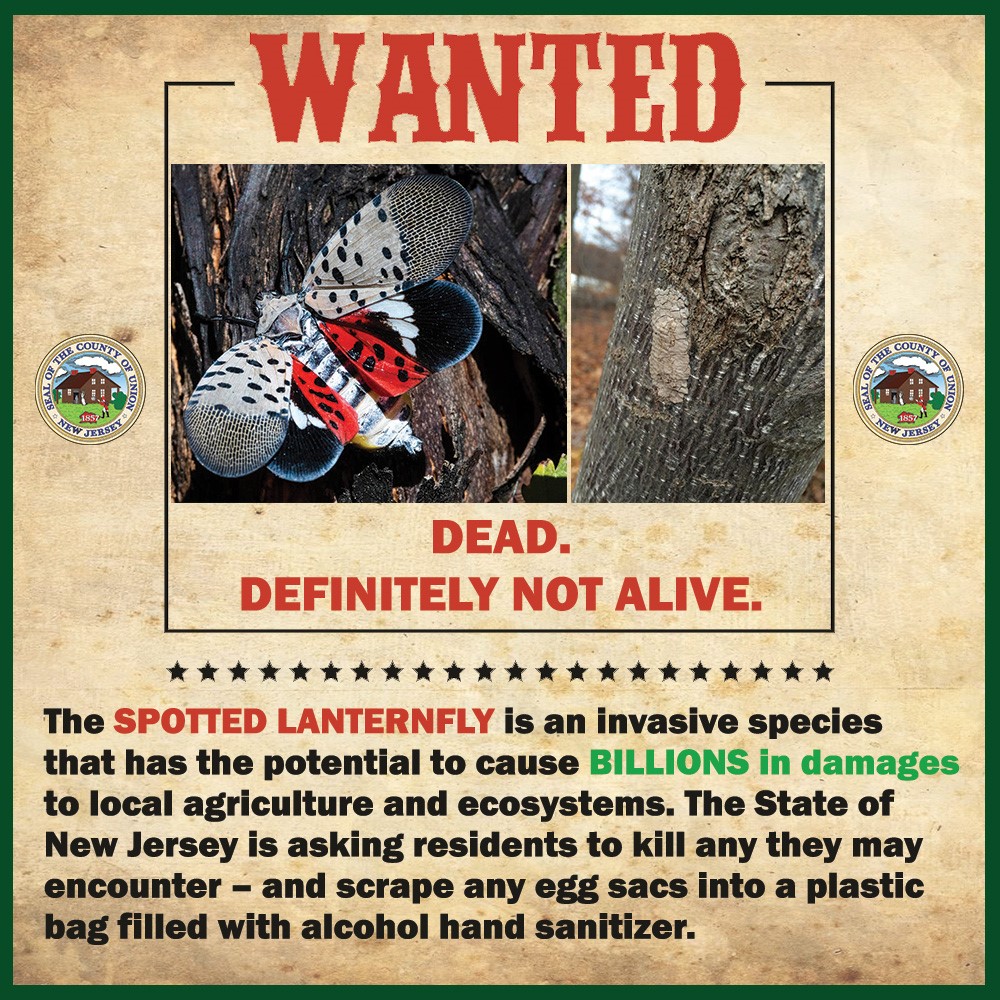 Invasive insect threatens native trees and plants, and can destroy valuable crops.
Invasive insect threatens native trees and plants, and can destroy valuable crops.
Union County residents who are looking for ways to help the environment are advised to be on the lookout for the spotted lanternfly, an invasive species that can destroy native trees like the black walnut, red maple, silver maple, and river birch. The spotted lanternfly is also notorious for damaging crops and ornamental flowers.
“Union County residents have worked hard to preserve open space and protect native habitat in our public parks, so we all have a stake in ensuring that the spotted lanternfly does not take hold in our area,” said Freeholder Chairman Al Mirabella. “I encourage everyone to help do a service to our native ecosystems by learning how to recognize this pest and its eggs, and destroying any that you encounter.”
The adult spotted lanternfly is easily recognized by black speckles on whitish upper wings and red lower wings. The insect lays egg masses of 30-50 eggs over a small area of about 1 inch, typically on flat surfaces including the outsides of vehicles. Masses laid on trees are mainly found about 10 feet above ground.
The spotted lanternfly is an invasive species of Asian origin that was originally confirmed to be spreading in Berks County, Pennsylvania, in September 2014. However, in 2018 the plant hopper was seen in New Jersey.
Lanternflies feed on more than 70 different trees and plants, but are particularly dangerous to New Jersey flora such as grapevines, roses, and the river birch, silver/red maple, and black walnut trees. Because of the lethality to these particular NJ plants, a lanternfly infestation could potentially prove damaging to New Jersey’s economy.
The New Jersey Department of Agriculture currently has eight counties under “quarantine” for the spotted lanternfly, including Burlington, Camden, Gloucester, Hunterdon, Mercer, Salem, Somerset, and Warren. Union County may soon be next on that list, as residents have reported lanternfly sightings in Westfield, Springfield, and more.
Residents are advised to kill any lanternflies they encounter, whether by force or sprayed insecticide. Since the spotted lanternfly typically lays its eggs in October, residents are also instructed to be on the lookout for egg sacs and, if spotted, scrape them into a plastic bag full of rubbing alcohol or hand sanitizer with at least 60% alcohol content.
Residents are also advised to inspect their cars for lanternflies or eggs after traveling to one of the aforementioned quarantine counties, particularly if on a hiking or other nature trip, and act accordingly to prevent the lanternfly from hitchhiking back to Union County.
Spotted lanternfly sightings should be reported to the New Jersey Department of Agriculture by calling 609-406-6943 or emailing slf-plantindustry@ag.nj.gov.
For more information, including photos of the lanternfly and its eggs at various stages, visit nj.gov/agriculture/divisions/pi/prog/spottedlanternfly.
For quick links to all Union County environmental programs and activities visit The Green Connection, ucnj.org/green-connection.
For more information and updates on all Union County services during the COVID-19 outbreak, including guidance for using the Drive-Through Test Center at Kean University and a list of locations for walk-up tests in local communities, visit ucnj.org/coronavirus-update.
For general information about COVID-19 and phone contacts for 24/7 assistance with questions, visit the New Jersey Department of Health at nj.gov/health.
# #
For all Union County programs and services visit ucnj.org, call the Public Info Line, 877-424-1234, email info@ucnj.org or use the online Contact Form.
Connect with Union County on social media.
